-
Paper Information
- Previous Paper
- Paper Submission
-
Journal Information
- About This Journal
- Editorial Board
- Current Issue
- Archive
- Author Guidelines
- Contact Us
International Journal of Library Science
p-ISSN: 2168-488X e-ISSN: 2168-4901
2013; 2(4): 69-79
doi:10.5923/j.library.20130204.02
Development of a Multi-Tier Internet-Based Library System
Iwasokun Gabriel Babatunde, Akinyokun Oluwole Charles
Department of Computer Science, Federal University of Technology, Akure, Nigeria
Correspondence to: Iwasokun Gabriel Babatunde, Department of Computer Science, Federal University of Technology, Akure, Nigeria.
| Email: |  |
Copyright © 2012 Scientific & Academic Publishing. All Rights Reserved.
The term electronic library (e-library) has been applied to a wide variety of domains such as collection of electronic materials and software agents that support inquiry-based education. One major and common property to these domains is digital coherence. The existing library systems serve as reservoir for several materials resulting in their non-effective in time taken to search and retrieve needed materials. This paper presents an Internet-Based Library System (ILS) that offers greater and efficient services. The system has modules for database, web browser and services affiliated to institutions of learning. The database module stores collections of data representing information of interest while the web browser module consists of application for enabling users access, removal and viewing of documents and other resources on the Internet. The web services module provides platforms for communication between electronic services on the web. The implementation environment is characterized by windows platform, Java script as the front-end engine and PHP and MySQL as the backend engines. Libraries of the six Departments of the School of Sciences, Federal University of Technology, Akure (FUTA), Nigeria were used as case studies to test the practicability of the proposed system. Obtained results from the evaluation of the system based on selected indices revealed the system’s suitability, adequacy and acceptability.
Keywords: Electronic Library, Information dissemination, Web, Independent Learning, Database
Cite this paper: Iwasokun Gabriel Babatunde, Akinyokun Oluwole Charles, Development of a Multi-Tier Internet-Based Library System, International Journal of Library Science, Vol. 2 No. 4, 2013, pp. 69-79. doi: 10.5923/j.library.20130204.02.
Article Outline
1. Introduction
- Library has remained a living record of people’s progress from the stone age to the present space age. Through libraries, people communicate their vision and experience from generation to generation. Today, it is confirmed that the role of educator to teach the users on how to find useful information both in the physical libraries and electronic networks is important. A library is not just an institution, building, or storehouse of materials, but an agent of educational, social, economic, and political changes or revolutions in the community, which their doors are well opened to all who need them[1]. Library is also a place that is entrusted with the acquisition, organization, preservation, storage, retrieval and dissemination of information in whatever format that it might appear[2-3]. In addition, a library is a body of recorded information (in various formats) selected, organized, retrieved, disseminated or made available to the needed users. The various formats of information records are books, newsletters, magazines, newspapers, films, filmstrips, CD-ROM, transparent materials, photographs, reference works, and so on. The objectives of a library depend on the purpose and level of its establishment and the users for which it was designed. The following are some of the general objectives of a library[4]:a. Provision of adequate, relevant and up-to-date resources to keep its users informed of the latest events, ideas, discoveries and development from all branches of knowledge.b. Training of students towards independent study, development of reading skills and profitable use of leisure periods.c. Widening of experience and developing inquiry minds in students and other users.d. Enriches the curriculum of societies and provide guidance in all aspects of library use.e. To identify, acquire, organize, and disseminate different forms of recorded information relevant to the interest of its clients. f. To cooperate with other libraries in developing beneficial resources sharing relationship.The authors in[4-6] present the functions of a library as follows:a. Information dissemination: the library acquires and organizes materials in various formats and disseminates them to users.b. Expansion of horizon of learning: library usually makes provision for a wide range of materials on various subjects taught in various levels of education. No teacher is an encyclopedia of knowledge, and neither can textbooks alone provide all the students needs. Through consultation of library materials, the knowledge of what has been taught in the classroom is widened.c. Independent learning: most lessons and lectures in colleges, polytechnics and universities are group activities. The library allows learners to learn individually at their own pace and rate as against the group activities in the classroom.d. Recreational role: the library does encourage recreation and therefore stocks various types of materials to facilitate this. Magazines, newspapers and so on are usually kept in the library, for pleasurable reading. e. Developing values, attitudes and appreciation: the library helps in the development of values, attitude and appreciation by providing experiences with various forms of creative expressions most especially through literature and arts.f. Economic role: the library provides an avenue for indigent students who cannot afford the costly textbooks and other relevant materials.Classification of libraries depends mainly on their ownership and purpose for which they were established. The mostly known types of libraries are national, public, academic, school, special and private libraries[7-8]. National library is the apex library in any country. It is owned by the Federal Government for the educational interest of her nationals. Every nation has one and they are cited in the Federal Capital and branches are established in each state, provincial or regional capitals. Some of the functions of a national library include preservation and storage of all intellectual output, maintenance of a National Union Catalogue (NUC), which brings together in one place, a complete record of the holdings of the nation’s books and maintenance of inter-library lending system. Others functions are making recommendation and assisting local and state governments who are interested in establishing libraries and keeping a complete collection of government’s publications.Public library is the University of People and serves all the various groups in the community. It is community based and supported by taxes, rates and levies. It is the avenue through which the overall information resources is made freely available to all stakeholders. Its functions include provision of educational development of people in the community, support for civic and cultural activities of groups and organizations, promotion and encouragement of wholesome recreation and positive use of leisure time and offering of user access to information over the whole range of human activities, such as agriculture, crafts, commerce and industry. Academic Libraries are found in higher educational institutions such as Colleges of Education, Polytechnics, Colleges of Technology and Universities. They perform functions directly related to the mission of each institution. Some colleges focus almost entirely on their curricula needs while universities also emphasize on research and the interest of the wider population. The general functions of academic Libraries are to provide materials required for the academic programmes of the institution, research information resources in consonance with the needs of faculty and research students and information resources for recreation and personal self-development of users. Academic libraries also provide protection and security of materials and specialized information service to appropriate segments of the wider community.School Libraries are libraries in primary, secondary, and technical schools. Their functions include provision of background materials to complement and supplement learning and classroom teaching, catalyst for learning and enrichment for teachers note and teaching methodology. They also provide opportunity for creativity and independent thinking and encourage children in the proper use of leisure. Special Libraries are established for research and provision of detailed and specialized informational needs, usually for the personnel of the organization concerned. The stocks of special libraries are more of journals, reports, conference, proceedings, documents, cuttings, illustrations and books. Examples of this kind of library are the libraries found in Ministries, Parastatal, Industrial and Research Institutes, Professional Associations, Banks, Medical Libraries, Law chambers and Newspaper Houses. Private Libraries are established by individuals, eminent scholars, politicians and other important personalities in the society who turned their book collections into libraries. Section 2, 3 and 4 of this paper present the traditional library system, electronic library and the proposed electronic library system respectively. The system implementation, evaluation and the conclusion are discussed in Sections 5, 6 and 7 respectively.
2. The Traditional Library System
- A traditional library comprises of a list of departments for maintaining the normal working mode of the library. In traditional libraries, books are primarily stored by subject, title, author and date and are accessed by following signs to the appropriate floor, room, bookcase, shelf, and spine-labeled book. The size and relative importance of each portion of the collection gives patrons information about the collection and can reveal the library's collection management objectives as well. The sub-units of the three main departments; namely technical services, reader services and research and bibliographic services in a traditional library are shown in the typical library organizational chart shown in Figure 1[9-12]. The technical department provides e-learning, acquisition, cataloguing, binding and serial supports. The readers’ services department provides all forms of support on circulation, reserved management and referencing while support on documentations, private collections and maps and manuscripts are rendered at the research and bibliographic department.
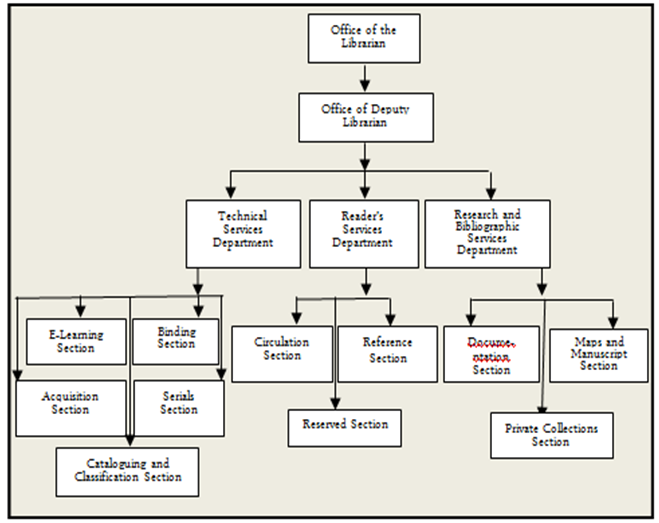 | Figure 1. Organizational structure of a standard conventional library |
3. Electronic Library
- Electronic Library, also known as digital library, has a variety of meanings, ranging from a digitized collection of material in a traditional library to the collection of all digital information along with the services that make them useful to all possible users. In summary, an electronic library is a collection of services and information objects that support users of the library in dealing with information objects and the organization and presentation of those objects which are available directly or indirectly via electronic/digital means [15]. A basic characteristic of the electronic library is that the information objects are found in collections with associated management and support functions. The types of information objects vary from traditional "documents" through to live objects such as sensor readings or dynamic query results. Its goal is to assist users by satisfying their needs and requirements for management, access, storage and manipulation of the variety of information stored in the collection of material that represents the "holdings" of the library. Users may be humans or they may be automated processes acting on behalf of or in support of human needs. Users also vary and include those not involved in the management and operation of the library but rather are the customers (end users), library operators, and information "producers" who want their material available through the library[16]. The authors in[17] summarize the major characteristic of electronic libraries as collections of fixed or permanent documents, which are based on digital technologies and are used by individuals working alone. Other characteristics include fixed contents, support from digital technologies, oriented towards information seeking [5,18]. The advantages of electronic library include the benefits of information collections in digital form for preservation and access and in management of large quantities of information. Digital libraries can store a large volume of digital information in archival form. It provides the users fast search tools and immediate access to the rapidly-growing information in multimedia form quickly on the screen in an interactive mode. It also offers access to expensive and special collections of information from any remote location and by multiple simultaneous users[19-20]. The fundamental reasons for building electronic libraries are as follows[21]:a. The digital library brings the library closer to the users making it easier to use and hence increasing its usage. With a digital library on the desktop, a user need never visit a library building. The library is wherever there is a personal computer and a network connection. The access to the collections expands beyond “working hours”.b. Computing power can be used to find information and it is considered to be better than manual methods for finding information particularly for reference work that involves repeated leaps from one source of information to another. Hyperlinks to other sources within a source provide obvious advantages.c. Placing digital information on a network makes it available to everybody or at least to those who have subscribed to it. This is a vast improvement over expensive physical duplication of material, or the inconvenience of traveling to a location where some unique materials are stored.d. Important information needs to be updated continually.Notable among the technologies for the implementation of electronic library is the Internet. The Internet is the interconnection of networks; that is, it is a network of networks. It is said to be a global meeting place where people from all parts of the world come together. Its service is always available on any computer in which from the fingertip, anyone can have access to it[22-23]. In most cases, e-library system transactions are of large volumes, which need to be secured. Security of e-library site require the use of highly secure protocols with efficient implementations. An example of such protocol is the Secured Socket Layer (SSL). The different components and layers of SSL are shown in Figure 2. SSL is a standard security technology for establishing an encrypted link between a web server and a browser (DonalO’Mahony et.al, 2001). The link ensures that all data passed between the web server and browsers remain private and integral. SSL is an industry standard and is used by millions of websites in the protection of their online transactions with their customers. SSL has recently been succeeded by Transport Layer Security (TLS), which is based on SSL. SSL uses program layers located between the Internet’s Hypertext Transfer Protocol(HTTP) and Transport Control Protocol (TCP) layers. It is included as part of both the Microsoft, Netscape and web server products. SSL is developed by Netcape and gained the support of Microsoft and other Internet client/server developers as well become the de facto standard until evolving into Transport Layer Security. The “sockets’’ refers to the socket method of passing data back and front between a client and a server programing a network or between a layers in the same computer.
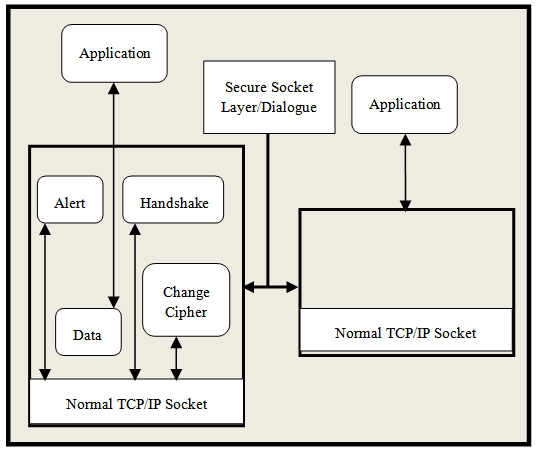 | Figure 2. The main protocol components of the Secure Socket Layer (SSL) |
4. The Proposed Electronic Library System
 | Figure 3. Architecture of the Electronic Customized Library System |
 | (1) |
4.1. Three Tier Design of the Proposed Web Based Electronic Library Syst/Em
- The design and implementation of the web based library system is based on a three- tier platform; namely front, middle and back end. The front-end is the presentation layer consisting of series of web pages presented to the users with the aid of a browser. It also presents the menu options showing information and available tasks at various levels of the system. The tasks cover, largely, the update and query transactions that can be performed on the database by authorized end and casual users. This tier is designed with HTML tags that give the structure of a page while JavaScripts determines the behaviour of the page. In addition, there are several free editors that support HTML tags. With JavaScript, there are small snippets of program code that make it easy for programmer to accomplish big tasks. The JavaScript interpreter is built into every scriptable browser [26-27] and there is no need of downloading or buying any additional software.The middle-end is the component of the web system that performs the logic of the system. It contains the system logic that decides how the middle-end serves as a bridge between the user at the front end of the application and the data at the back-end. It also contains the web server, which processes requests made by users. This tier is implemented using Hypertext Preprocessor formally known as Personal Home Page (PHP) Scripts that runs 5 to 20 times faster than Java and is extremely easy to use in developing very complex web applications, in a considerable period of time. It combined the object oriented features of Java, C++, PERL and “C” languages. PHP is the real gem of all the scripting / programming languages and has a huge number of users worldwide (PHP, 2003). The back end holds in a secured manner, all the application databases that stand as a backbone to the system. The databases are kept secure through the implementation of authentication and authorization of users. This tier is also responsible for creating effective and efficient backup and recovery strategies. The choice of database management system for the proposed system is My Structured Query Language (MySQL). MySQL is a fast Relational Database Management System with the functionalities found in varying leading database applications. It does not carry a hefty price tag as it is open source software and it can be easily downloaded[28].
4.2. Technological Design of the Web Based Library System
- The proposed system is platform independent. With the use of WAMP, which is a suite, comprising of Windows, Apache, MySQL and PHP, the system can work efficiently on a windows based computer system. LAMP and XAMMP are also examples of such suites that can enable the perfect running of the system on Linux and Macintosh respectively. The general technological design of the web-based system on the WAMP platform is shown in Figure 4.
 | Figure 4. Technological design of the Web Based System |
 | Figure 5. Communication Flow Chart between the Technologies of the System |
5. System Implementation
- The proposed system was implemented in an environment characterized by windows Vista Home Basic Operating System on a Pentium IV with 1GB main memory and 40GB Hard disk. The supporting Internet system is built using server connected to Very Small Aperture Terminal (VSAT) with a unique IP address for hosting or network interface identification and location addressing with support for file with size exceeding 2 GB on 32 bits operating system. The server is maintained with bandwidth size of 256 Mb/s using Java and ASP.net client side scripting. For continuous power supply, Un-interrupted Power Supply Systems (UPS) and Voltage Regulators (VR) were provided. Even though the servers rely on the power supply from the national grid, an alternative power generator is available to guide against system failure occasioned by power outage from the national grid. The system quality, reliability and maintainability are enhanced with detailed designed, graphical and friendly user interfaces, good test procedures, and system documentations. The distinctiveness of the system is proved by its user friendliness and descriptive link names. The home page of the web-based electronic library system is loaded once the address of the web system is loaded in a browser such as Mozilla Firefox, Opera and Internet Explorer. This page displays a list of links via which other parts of the system can be navigated. The login page was carefully coded in order to validate and verify the authenticity of the user. All categories of users are allowed to make use of the system on successful authentication through the login interface featuring the username, password and user type. The user type signifies the user level, which can either be ‘student’ or ‘staff’. After a successful user verification, a welcome message and a pointer to the user’s department are presented. Details of suggested books are also presented for the active session. User confirmation is done at the staff module to determine the access level. Every staff on access is restricted by the system to the level specified for the category of which he or she belongs. The staff module has pages for creating record of new staff, viewing staff details, query students records, book registrations and shelf management. The first part of the file used for capturing, storing and viewing details of a library staff on the database gives the user a free-will to choose the username and password with which he/she will access the system in subsequent occasions. The other personal details of the staff such as title, names, home address, school, department, contact number, e-mail address, type and highest qualification formed the other part. Information about an active staff can be displayed, modified or printed using the appropriate buttons.
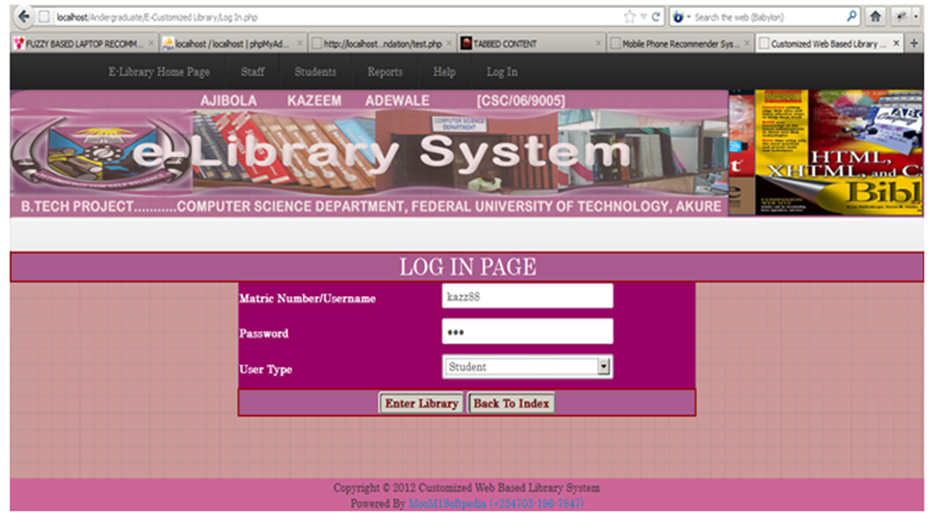 | Figure 6. A Screen-print of Login Page for E-Customized Library System |
 | Figure 7. Screen View of ‘Book Shelf’ Page |
6. System Evaluation
- The proposed customized library system was tested using the library collections of the six Departments of the Schools of Sciences of The Federal University of Technology, Akure, Nigeria (FUTA). The Departments are Biochemistry (BCH), Microbiology (MCB), Computer Science (CSC), Physics (PHY), Mathematical Sciences (MTS) and Statistics (STA). The library of each Department is equipped with facilities to support effective utilization of resources through competent staff activities. Students’ access to available resources is also prioritized. Each library has about one thousand five hundred books on related fields in its shelf. To verify the efficiency of the system, a formative evaluation of the system based on the view of selected staff and learner users was conducted in line with some indices. The view and responses of randomly selected respondents (one hundred learners and ten staff) from each of the six Departments were sampled using questionnaire method. The selections of the respondents were freely done without any form of bias. The first section of the questionnaire focused on the relevant information about the respondent. These include name, department, level (for learner) and designation (for staff). The second section featured the evaluation indices which include accessibility, availability, provision of appropriate level of interaction, menu driven support, efficiency of support for learning methods, convenience in use and usefulness for active learning. The indices were rated on a scale of 5, 4, 3, 2 and 1 for ‘Excellent’, ‘Very Good’, ‘Good’, Average’ and ‘Poor’ respectively. Summaries of the ratings of the system by the learners and staff are presented in Tables 1 and 2 respectively. According to the figures in Table 1, all the 600 surveyed learners from the six departments gave average ratings of 4.06, 4.24, 4.22, 4.15 and 4.58 for the proposed web-based library system in term of the ‘accessibility’, ‘availability’, ‘provision of appropriate level of interaction’, ‘convenience of use’ and ‘usefulness for active learning’ respectively. Based on the rating scale, these values indicate above ‘Very Good’ performance of the system from the views of the surveyed learners for the concerned indices. The students from the six departments also rated the system a little below ‘Very Good’ on its performance scale for ‘menu driven support’ and ‘efficiency of support for learning method’ with average ratings of 3.75 and 3.93 respectively. The below ‘Very Good’ support for ‘Menu driven support’ is attributed to the sparingly nature of the help or support modules. This performance scale for ‘Efficiency of support for learning method’ is also attributed to the non-inclusion of some relevant texts and materials in the collections of the six libraries used for the evaluation.
|
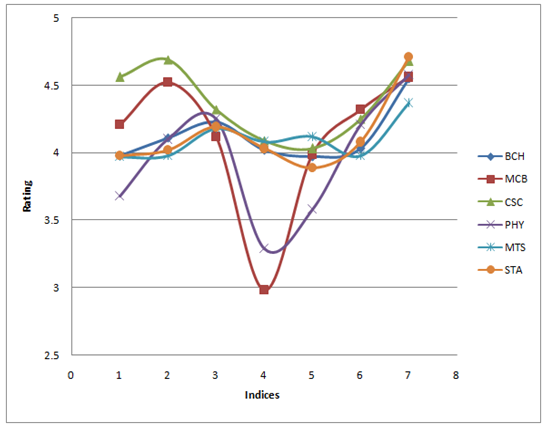 | Figure 8. Scatter Chart of the learners’ ratings |
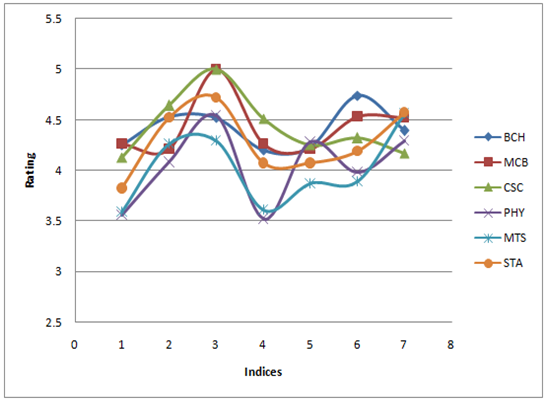 | Figure 9. Scatter Chart of the staff ratings |
7. Conclusions
- Electronic Library System are been used to support the Manual Library System such that the ease of access and maintenance of the library materials provides solution to a wide variety of problems on the maintenance of electronic journals, inquiry-based education, e-mail for an organization and personal information collections. The current concept of e-library is a subset of the larger concept of library and not a substitute for it. The development of public library systems does not address the main characteristics of the conception of library system that include technology, users’ domain, contents and services. Yet, model of technological support for libraries varies from Public (Generalized) Library to Academic (Customized) Library. The design and implementation of a customized web- based library system with three tier architecture comprising of the Front-end, Middle-end and Back-end has been presented. The front-end engine is the browser (an application that access web pages) with which the users interact with the system. The middle-end engine contains the Application Engine characterized by update and query transactions. It also has the Web Engine, which serves as the interface between the Application Engine and Users of the system. Lastly, is the back-end engine, which houses the relational database on which the system keeps its data. With the proposed system, it is possible to maintain easy access and maintenance of documents and materials in any library with great emphasis on system personalization. The system provides adequate security and privacy mechanisms with a view to guaranteeing the integrity of its database. The profile of the administrator and users (staff and students) of the system are appropriately authenticated at the levels of entry into the application. The satisfactory performance of the system based on the ratings of the respondents indicates its meeting up with the conclusion in[16, 21] that digital libraries should meet the needs of users in term of resources availability and access. The satisfactory nature of the system also confer on it, relevance in term of independent study and resource control which are presented in[17] as parts of the major characteristics of electronic library system. Future research aims at improving the performance ratings especially in areas of ‘Menu driven support’ and ‘Efficiency of support for learning method’ through enhanced and fortified help modules and inclusion of additional study materials in the digital collections. Consideration will also be given to alternative platform, front-end, middle-end and back-end engines with more emphasis on open sourced applications that are versatile and robust with improved privacy and security features.
References
| [1] | Ellis Jenny and Kealy Karen, 2011, ‘Building a ‘storehouse of wisdom’ with an environmental conscience: a work in progress’(http://conference.ifla.org/ifla77), Accessed14/05/2012 |
| [2] | Aiyebelehin, James Afebuameh, "General Structures, Literatures, and Problems of Libraries: Revisiting the State of Librarianship inAfrica" (2012). Library Philosophy and Practice (e-journal). Paper 832(http://digitalcommons.unl.edu/libphilprac/832), Accessed 27/01/2013 |
| [3] | Abdulsalami L. T. , Okezie Q. I. and Agbo A. D., 2013: ‘The role of the library in the promotion of knowledge societies in Nigeria’, Advances in Applied Science Research, 2013, 4(1):58-70 |
| [4] | Digital Library Technology Trends (DLTT, 2002), The Sun Microsystem(www.ncsi.iisc.ernet.in/raja/is214/is214-2005-01-04/digital_library_trends-020923.pdf), Accessed16/10/2012 |
| [5] | Almisned Faisal Abdulaziz and Alanazi Nasser ALhomide (2007):’Electronic Library System’, B.Sc. Thesis Submitted to Department of Information Systems College of Computer and Information Sciences King Saud University |
| [6] | Pirounakis G., Saidis K., Nikolaidou M., Lourdi E., ‘Designing an Integrated Digital Library Framework to support Multiple Heterogeneous Collections’(www.dit.hua.gr/~mara/publications/ecdl04.pdf), Accessed 11/02/2012 |
| [7] | Gupta Jyatsna; Types of Libraries, unpublished(www.kuk.ac.in/userfiles/distance.education/year-2011-2012B_Lib%lecture201.pdf, Accessed 12/12/2012 |
| [8] | Magrill Rose Mary (1985): Evaluation by Type of Library, Library and Information Sciences, North Texas State University, Denton, Texas(www.ideals.illinois.edu/bitstream/handle/2142/7383/librarytrendsv33i3d_opt-pdf?sequence=1), Accessed 17/10/2012 |
| [9] | Sweeney Richard T. (1994), Information Services, Polytechnic University, 5 MetroTech Center, Brooklyn, NY 11201 LIBRARY TRENDS, Vol. 43, No. 1, Summer 1994, pp. 62-94 |
| [10] | Thornton G A. (2000): Impact of Electronic Resources on Collection Development, the Roles of Librarians, and Library Consortia, LIBRARY TRENDS, Vol. 48, No. 4, Spring 2000, pp. 842-856 |
| [11] | Hawkins Brian L. ‘The Un-sustainability of Traditional Library and the Threat to Higher Education,(lib.colostate.edu/images/about/goals/it/libraryunsustainability.pdf), Accessed 15/09/2012 |
| [12] | Halbert Martin, Hartman Cathy, Paz Susan et al.(2010):’Library Organizational Structure Plan’, UNIVERSITY OF NORTH TEXAS LIBRARIES |
| [13] | Blandford Ann, Stephann Makri & Jeremy, Jon Rimmer & Claire Warwick, George Buchanan (2011):A Library or Just another Information Resource? A Case Study of Users’ Mental Models of Traditional and Digital Libraries (discovery.ucl.ac.uk/5097/1/5097.pdf), Accessed 23/12/2012 |
| [14] | Thorhauge Jens and Jepsen, Thorlund Erik (2011): Success or failure of digital library services – a decade of Danish Experiences (http://conference.ifla.org/ifla77). Accessed 18/07/2012 |
| [15] | Barry M. Leiner (1998), “The Scope of the Digital Library”, DLib Working Group on Digital Library Metrics,Stanford University. |
| [16] | Harter, S. (1997), “Scholarly communication and the digital library: Problems and Issues”, Journal of Digital Information. http://jodi.ecs.soton.ac.uk. Accessed on: 23/01/ 2012 |
| [17] | Levy, D.M & Marshall, C.C. (1995), “Going digital: A look at assumptions underlying digital libraries”.Communications of the ACM, Vol. 38, Article 4, pg. 77-84. |
| [18] | Mary E. Brown (2005), “History and definition of digital libraries”, Department of Information & Science, Southern Connecticut State University, New Haven, |
| [19] | Montgomery, Carol H. and King, Donald W, (2002), “After Migration to an Electronic Journal Collection”, D-Lib Magazine, Vol. 8, No.12(http://www.dlib.org/dlib/december02/king/12king.html), Accessed 20/02/ 2012 |
| [20] | DonalO’Mahony, Michael Peirce, and Hitesh Tewari (2001), “Electronic Payment Systems for E-Commerce”, Second Edition, Artech House computer security series, ISBN 1-58053-268-3 |
| [21] | Robertson, S., Jitan, S., & Reese, K. (1997).“Web-based collaborative library research”. Proceedings of the 2nd ACM International Conference on Digital Libraries, Pg. 152-160. |
| [22] | W3C (2004), “Web Services Glossary”,(http://www.w3c.org/web servicees), Accessed 22/06/2012. |
| [23] | Organisation for Economic Co-Operation and Development [OECD], 2010 ‘The Role of Internet Intermediaries in Advancing Public Policy Objectives”, |
| [24] | The Relational Data Model[RDM], 2012(i.stanford.edu/~ullman/focs/ch08.pdf), Accessed 18/07/2012 |
| [25] | The Relational Data Model[TRDM], 2010(www.macs.hw.ac.uk/trinder/dbinfsystems/3-relmodel.pdf), Accessed18/07/2012 |
| [26] | JavaScript, 2003 (www.quirksmode.org/js/intro.html), Accessed 28/01/2013 |
| [27] | JavaScript, 2010 (www.uotechnology.edu.iq/sweit/ Lectures/ AhmedSaad-Internetprog-SW/part05.pdf), Accessed28/01/2013 |
| [28] | OpenOffice.org 1.0, ODBC, and MySQL 'How-to' (www.unixodbc.org/doc/OOoMySQL.pdf), Accessed 28/01/2013 |
 Abstract
Abstract Reference
Reference Full-Text PDF
Full-Text PDF Full-text HTML
Full-text HTML